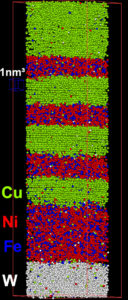As a child, when I was taught about atoms and molecules, it was a concept my mind couldn’t comprehend. Everything is made of the same molecular components of atoms, and yet they are somehow arranged to be either the solid land we stand on, the water we drink and the air we breathe. It was a lesson in physics I read, but never really understood.
It was not until I came across the images from one of the most advanced telescopes in the world that I grasped what my physics book had feebly tried to explain.
The Atom Probe Microscopes are a kind of 3D microscopes which reconstruct the structure of an object atom-by-atom. Here’s an image, or more accurately, a visualisation of Cu/Ni-Fe compound, where each dot represents an atom.

We’ll get to its incredible working in a bit and see why it’s called a ‘visualisation’ rather than an ‘image’.
The microscope is an insight into studying one of the most powerful, yet the smallest things in the universe–atoms–and why they behave the way they do.
Now, various students and institutions across India will have access to the world’s first remotely operable Local Electrode Atom Probe (LEAP) microscope, right here in Chennai!
Unveiled on the 16th of July at the National Facility of Atom Probe Tomography (NFAPT), the LEAP microscope was commissioned by the Indian Institute of Technology, Madras.
The high-performance microscope was created in collaboration with eight top research institutes in India, and the Rs 40 crore project is determined to enhance the knowledge in the fields of nanotechnology and atomic physics.
During the inauguration, Prof Bhaskar Ramamurthi, Director, IIT Madras, said, “This model, where several institutes come together to fund expensive research equipment is a useful one and can be replicated in institutions across the country. Commercial users paying a fee to use such equipment for their industrial research also make such equipment economically viable.”
Calling the LEAP a microscope would be partially incorrect, as the LEAP evaporates the subject it analyses.
The basic principle of the LEAP is that a compound is taken and sharpened to an extremely sharp needle-like structure. Then, according to its conductivity, it is either treated with electroplating or subjugated to an ion beam.
It is then hit with high-intensity pulsing lasers, which tear through the composition of the compound, disintegrating it into individual atoms.
The evaporated atoms are then detected with a sensor kept at a known distance from the compound. And the atoms are classified according to a spectrometer.
This data is then used to reconstruct the compound and produce a 3D visualisation. This is why it is called a ‘visualisation’ rather than an ‘image’.
This facility will be able to provide atomic-scale insights into metallic materials, alloys, and semiconductors, all of which can enhance the application in industries such as steel, automobile, energy and various other sectors.
Speaking about the benefits of LEAP, Prof B S Murty, Principal Investigator of the NFAPT Project, IIT Madras, told The New Indian Express, “There are numerous problems that can be resolved using this facility, and I’m really looking forward to the equipment being put to good use by Researchers.”
With all this insight into atoms and molecules, let’s hope the future generations have a better grasp of physics than we ever did.
(Edited by Shruti Singhal)
Hey, you may also like: India’s First Robotic Telescope at Ladakh Opens Its Eyes To the Universe!
Like this story? Or have something to share?
Write to us: contact@thebetterindia.com
Connect with us on Facebook and Twitter.
NEW: Click here to get positive news on WhatsApp!
If you found our stories insightful, informative, or even just enjoyable, we invite you to consider making a voluntary payment to support the work we do at The Better India. Your contribution helps us continue producing quality content that educates, inspires, and drives positive change.
Choose one of the payment options below for your contribution-
By paying for the stories you value, you directly contribute to sustaining our efforts focused on making a difference in the world. Together, let's ensure that impactful stories continue to be told and shared, enriching lives and communities alike.
Thank you for your support. Here are some frequently asked questions you might find helpful to know why you are contributing?

